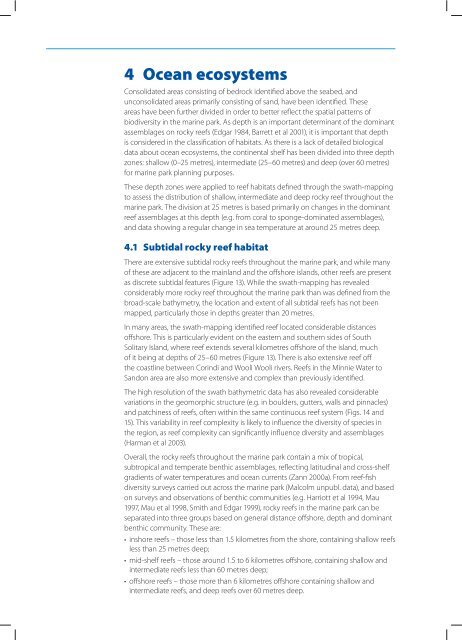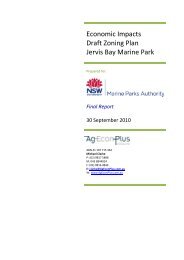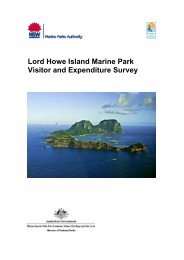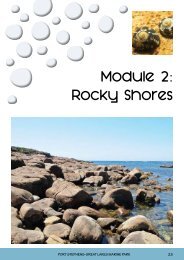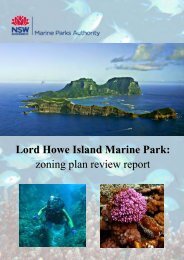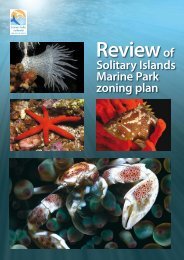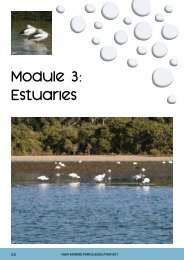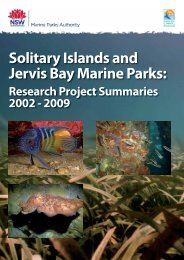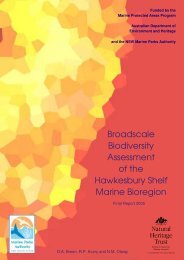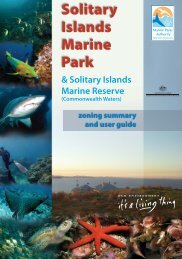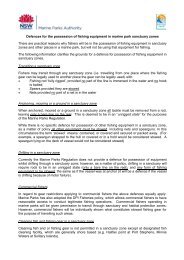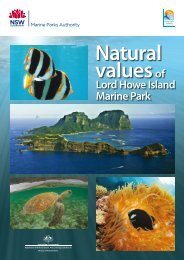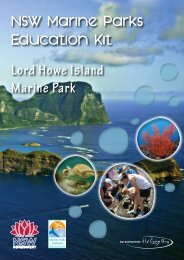Natural values of the Solitary Islands Marine Park - Marine Parks ...
Natural values of the Solitary Islands Marine Park - Marine Parks ...
Natural values of the Solitary Islands Marine Park - Marine Parks ...
- No tags were found...
You also want an ePaper? Increase the reach of your titles
YUMPU automatically turns print PDFs into web optimized ePapers that Google loves.
4 Ocean ecosystemsConsolidated areas consisting <strong>of</strong> bedrock identified above <strong>the</strong> seabed, andunconsolidated areas primarily consisting <strong>of</strong> sand, have been identified. Theseareas have been fur<strong>the</strong>r divided in order to better reflect <strong>the</strong> spatial patterns <strong>of</strong>biodiversity in <strong>the</strong> marine park. As depth is an important determinant <strong>of</strong> <strong>the</strong> dominantassemblages on rocky reefs (Edgar 1984, Barrett et al 2001), it is important that depthis considered in <strong>the</strong> classification <strong>of</strong> habitats. As <strong>the</strong>re is a lack <strong>of</strong> detailed biologicaldata about ocean ecosystems, <strong>the</strong> continental shelf has been divided into three depthzones: shallow (0–25 metres), intermediate (25–60 metres) and deep (over 60 metres)for marine park planning purposes.These depth zones were applied to reef habitats defined through <strong>the</strong> swath-mappingto assess <strong>the</strong> distribution <strong>of</strong> shallow, intermediate and deep rocky reef throughout <strong>the</strong>marine park. The division at 25 metres is based primarily on changes in <strong>the</strong> dominantreef assemblages at this depth (e.g. from coral to sponge-dominated assemblages),and data showing a regular change in sea temperature at around 25 metres deep.4.1 Subtidal rocky reef habitatThere are extensive subtidal rocky reefs throughout <strong>the</strong> marine park, and while many<strong>of</strong> <strong>the</strong>se are adjacent to <strong>the</strong> mainland and <strong>the</strong> <strong>of</strong>fshore islands, o<strong>the</strong>r reefs are presentas discrete subtidal features (Figure 13). While <strong>the</strong> swath-mapping has revealedconsiderably more rocky reef throughout <strong>the</strong> marine park than was defined from <strong>the</strong>broad-scale bathymetry, <strong>the</strong> location and extent <strong>of</strong> all subtidal reefs has not beenmapped, particularly those in depths greater than 20 metres.In many areas, <strong>the</strong> swath-mapping identified reef located considerable distances<strong>of</strong>fshore. This is particularly evident on <strong>the</strong> eastern and sou<strong>the</strong>rn sides <strong>of</strong> South<strong>Solitary</strong> Island, where reef extends several kilometres <strong>of</strong>fshore <strong>of</strong> <strong>the</strong> island, much<strong>of</strong> it being at depths <strong>of</strong> 25–60 metres (Figure 13). There is also extensive reef <strong>of</strong>f<strong>the</strong> coastline between Corindi and Wooli Wooli rivers. Reefs in <strong>the</strong> Minnie Water toSandon area are also more extensive and complex than previously identified.The high resolution <strong>of</strong> <strong>the</strong> swath bathymetric data has also revealed considerablevariations in <strong>the</strong> geomorphic structure (e.g. in boulders, gutters, walls and pinnacles)and patchiness <strong>of</strong> reefs, <strong>of</strong>ten within <strong>the</strong> same continuous reef system (Figs. 14 and15). This variability in reef complexity is likely to influence <strong>the</strong> diversity <strong>of</strong> species in<strong>the</strong> region, as reef complexity can significantly influence diversity and assemblages(Harman et al 2003).Overall, <strong>the</strong> rocky reefs throughout <strong>the</strong> marine park contain a mix <strong>of</strong> tropical,subtropical and temperate benthic assemblages, reflecting latitudinal and cross-shelfgradients <strong>of</strong> water temperatures and ocean currents (Zann 2000a). From reef-fishdiversity surveys carried out across <strong>the</strong> marine park (Malcolm unpubl. data), and basedon surveys and observations <strong>of</strong> benthic communities (e.g. Harriott et al 1994, Mau1997, Mau et al 1998, Smith and Edgar 1999), rocky reefs in <strong>the</strong> marine park can beseparated into three groups based on general distance <strong>of</strong>fshore, depth and dominantbenthic community. These are:• inshore reefs – those less than 1.5 kilometres from <strong>the</strong> shore, containing shallow reefsless than 25 metres deep;• mid-shelf reefs – those around 1.5 to 6 kilometres <strong>of</strong>fshore, containing shallow andintermediate reefs less than 60 metres deep;• <strong>of</strong>fshore reefs – those more than 6 kilometres <strong>of</strong>fshore containing shallow andintermediate reefs, and deep reefs over 60 metres deep.


